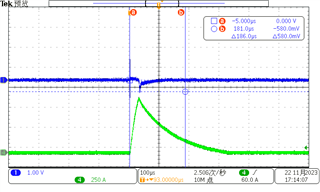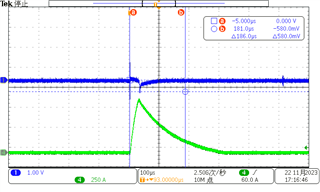Other Parts Discussed in Thread: EV2400, BQSTUDIO, BQ76940,
Hello TI Expert
I want to use TS1 as the ADCIN function, and I want to know what is the calculation formula for converting the ADC count value obtained from TS1 to the ADC value.
Thanks.
This thread has been locked.
If you have a related question, please click the "Ask a related question" button in the top right corner. The newly created question will be automatically linked to this question.
Hi Zhang,
See this previous thread for a document that details how to use the raw ADC measurements: BQ76952: TS1 ADC acquisition error issue - Power management forum - Power management - TI E2E support forums.
Regards,
Max Verboncoeur
Hi Max,
Thank you for your answer, my problem has been solved, and I would like to know more about it. The recovery time of my COV and CUV is a little high now, and this phenomenon only occurs on COV and CUV. My recovery time is 3s, but when I use the oscilloscope to check, the actual recovery time is about 4s. So I want to know why this phenomenon appears in the recovery of COV and CUV.
thanks,
Hi Zhang,
Can you double check that this (below) is not the case?

Regards,
Max Verboncoeur
Hi Max,
CHG FET Protections A set 0x98 and DSG FET Protections A set 0xE4.And this is only the case with COV and CUV recovery
Hi Max,
When I was using SCD, I used the method of external short circuit to test SCD, and I found that there would be a phenomenon of SCD failure. When I set the external short circuit, it would automatically shut down FET when my protection time was greater than 90us, but it would not show fault. On the contrary, everything was normal when the protection time was less than 90us. May I ask what the reason is?
Hi Zhang,
Can you show a waveform of the COV/CUV recovery delay? Do note that the recovery timer will not start until the cell voltage passes its hysteresis threshold (COV: Cell_V = COV_Threshold - COV_Hysteresis; CUV: Cell_V = CUV_Threshold + CUV_Hysteresis).
Regarding the SCD, can you capture a waveform of the voltage between the SRP and SRN pins as close to the pins as possible and make a note of what the SCD settings are? That way it will be easier to determine what the device is actually seeing and if it should trigger SCD or not.
Regards,
Max Verboncoeur
Hi Max,
This is the waveform of SRN, voltage and short circuit current at both ends of SRP that I intercepted by using external short circuit. The first picture is the waveform with SCD protection time greater than 70us, and the second picture is the waveform with SCD protection time less than 70us,When the value is greater than 70us, the BQ will report a fault. However, both methods are protected by BQ, only the difference in fault reporting


Hi Max,
I found that when COV occurs in BQ, I use discharge and it will not recover, and CUV will not recover because of charging.
Looking forward to your reply.
Hi Zhang,
Protections:SCD:Delay controls how long the measured current has to exceed the threshold for a SCD fault to trigger. If the measured current drops below the threshold before the time is up, then the fault will not trigger. You may want to check in the event where the SCD does not trigger but the FETs turn off that another fault has not triggered instead.
In regards to the COV and CUV, can take a log of this behavior? Measuring all the cell voltages (the device's measurements, not physical measurements) and the Safety Status A-C registers. Also make a note of what the COV and CUV thresholds are set to, as well as the Recovery Hysteresis settings for each.
Regards,
Max Verboncoeur
Hi Max,
1. As you said, my SCD protection may be caused by too long protection delay time, but as shown in the oscilloscope waveform, BQ has been protected when SCD occurs, but I can't see the fault display in A-C when the protection delay time is greater than 70us, my SCD threshold is 200A, is the threshold set too large? Or some other reason.
2. What I want to express is that when COV happens to me, my cell voltage remains unchanged, at this time I have discharge current, and the cell voltage does not reach the recovery value, then the COV fault will not recover? Will not restore based on current?
thanks.
Hi Zhang,
1. You may try capturing the SRP-VSS and SRN-VSS voltages on a scope to see if the 0.5V recommended limit is being exceeded. In some cases this has been observed to cause the FETs to turn off.
2. COV does not recover based on current, just on the cell voltage crossing the recovery threshold. I recommend observing the voltages at the device's input pins, not the cells, to get a better measurement of what voltage the device is reading. You can also use bqStudio to take a log of the device's measurements and registers if you have access to an EV2400.
Regards,
Max Verboncoeur
Hi Max,
If COV and CUV cannot be restored by current, is there any recommended method? Because BQ76940 can manually clear the fault, I think BQ76952 will recover the COV fault when the discharge current is detected when the COV fault occurs, and the CUV will also recover the fault when the charging current is detected. In this case, the two can recover even if the collected voltage value does not change. If not, it is expected that the CHG FET of the discharge current can be turned on when the COV fails, and the DSG FET of the charging current can be turned on when the CUV fails.
Can both methods be achieved?
Or there are other recommended methods.
thank you.
Hi Zhang,
The only method to recover from the COV and CUV faults is to bring the cell voltage back to the recovery threshold. The device will still allow discharging in COV and charging in CUV to allow this to occur. The device does not consider the current and its polarity for the cell voltage protections.
In COV, charging will be blocked entirely, and in CUV, discharging will be blocked entirely to prevent the faulty cell from over charging or over discharging and creating an unsafe condition. Once the cell voltage is within a safe range, the disabled FET will turn back on unless other fault conditions prevent it.
Regards,
Max Verboncoeur